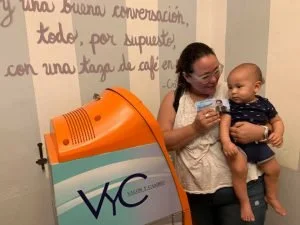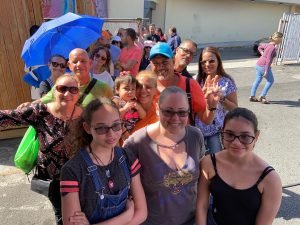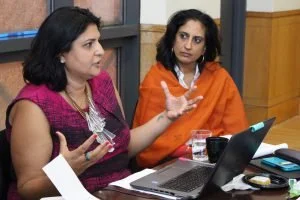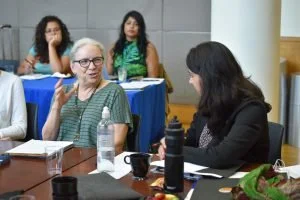Statement of Support for Ayse Gül Altinay from the Columbia University Center for the Study of Social Difference and Women Creating Change
Our colleague Ayse Gül Altinay, Professor of Anthropology and Director of the Gender and Women’s Studies Center at Sabanci University in Istanbul, Turkey, was sentenced to 25 months in prison earlier this week. She is one of over 2200 Academics for Peace who three years ago signed a statement “We will not be a party to this crime” appealing for an end to violent state-sponsored persecution of Kurdish citizens of Turkey. The investigation in Istanbul has covered only the first 1200 signatories so far, but it might be extended to the second 1000 as well. In this, her fourth, judicial hearing, Altinay was charged with “willingly and knowingly supporting a terrorist organization as a non-member.” The court's charge and thus the sentencing have no merit.
Ayse Gül Altinay has been a Faculty Fellow of Columbia’s Center for the Study of Social Difference since 2013. She is a co-organizer of the Working Group on “Women Mobilizing Memory” and a co-editor of the forthcoming Women Mobilizing Memory volume (Columbia University Press, 2019). Last September, she was also an invited speaker at the Center’s tenth anniversary conference “What We Can Do When There’s Nothing To be Done.” Her collaborative project “Curious Steps”— a gender-memory walk through Istanbul – spurred other such memory walks in additional sites including Harlem. Ayse Gül Altinay’s contributions to the Center’s work have been immeasurable: her feminist commitment to nonviolent protest and to transformative activism; her sharp insights into the workings of power and militarism and her determination to fight them; her fierce hopefulness combined with personal kindness, warmth and radiance have been an inspiration to all of us fortunate to be working with her.
In the spirit of collaboration and solidarity that Ayse Gül Altinay represents, it is important to point out that she is not alone in this struggle. Hers is one of a large number of cases receiving 25-month sentences that cannot be commuted. These cases, hers included, are in the process of being appealed. Some shorter sentences have been commuted, and many other colleagues are awaiting court dates over the next months. This is the time to speak out forcefully on all of their behalf and on behalf of freedom of expression and academic freedom.
On May 21st, 2019, Ayse Gül Altinay made the following statement to the court:
Every individual, every family living in this geography has suffered from past wars, migrations and experiences of violence. In terms of the cycle of violence that trauma studies alerts us to, we live in a challenging, vulnerable geography.
Yet, what we make of these past experiences of pain is up to us...
Are we going to turn our pain into more violence, hate, pain and injustice, or into steps that multiply life, beauty, love, peace and justice?
This is the main question that shapes my work and my life.
I firmly believe that we all have new steps we can take towards healing the traumas that have been transmitted from one generation to the other, and to break out of the cycles of violence that we are living through.
We, at CSSD and Columbia Global Freedom of Expression stand in solidarity and admiration for Ayse Gül Altinay and all of our academic colleagues who are being persecuted for their courage to speak out against violent aggression. The injustice of these sentences cannot be tolerated.
Disrupting Money: Puerto Rican Community Currency Project Makes Its Way to New York for the 2019 Loisaida Festival
Following a successful launch earlier this year, Puerto Rican artists will begin circulating Puerto Rican ‘pesos’ at the Lower Manhattan Festival ahead of one-month residency in the city.
NEW YORK, NY - On May 26, Valor y Cambio, an interactive community currency project that seeks to challenge austerity policies in Puerto Rico and beyond, will have its New York City premiere at the 2019 Loisaida Festival, followed by a one-month residency that will include collaborations with local businesses and other venues. The project is part of Pasado y Presente: Art After the Young Lords 1969-2019, an exhibition produced by Loisaida Inc. in partnership with Nathan Cummings Foundation, that will open on May 31.
At the core of Valor y Cambio (#ValorYCambio) is a community currency, the peso of Puerto Rico, inspired by Puerto Rican figures recognized both locally and internationally for their contributions to social justice. Building on the research of Unpayable Debt, a working group at the Columbia University Center for the Study of Social Difference, artists Frances Negrón-Muntaner and Sarabel Santos Negrón first launched the project in Puerto Rico in February 2019. The pesos were available at partner businesses and organizations, through an ATM machine, which dispensed the bills in return for participants recording a short video about what they value. Over a thousand people shared their thoughts and stories during the project’s first week.
By combining art, storytelling, and solidarity economy principles, Valor y Cambio started a broad conversation about what is a just economy and how to foster collective empowerment in the face of austerity policies. “Through engaging with local communities and businesses that are willing to use the currency for a specific period of time, the project provides "an experience about how the economy can better respond to the needs of most people,” explains Frances Negrón- Muntaner. “It also allows participants to create a different conception of wealth based not on extraction and profit, but full access to education, environmental protection, and racial and gender equity, among other fundamentals."
Community currencies are increasingly used around the world to value the skills, stories, and talents of communities with limited access to the official currency. These currencies do not substitute the official one, but they enable communities to exchange work, time, and resources to meet their needs. There are thousands of community currencies circulating in the world, including in the United States.
The Puerto Rican peso has six denominations, each featuring a figure or community selected for their commitment to the project’s four core values: solidarity, equity, justice, and creativity. They are: the siblings Gregoria, Celestina, and Rafael Cordero, pioneers of Puerto Rico’s modern public education system; the abolitionist physician Ramón Emeterio Betances; feminist and labor organizer Luisa Capetillo; poet Julia de Burgos; human rights advocate and MLB Hall of Famer Roberto Clemente; and the eight communities of the Martín Peña channel in San Juan.
"Each bill tells a story and invites a conversation about the contributions that these figures and communities made toward a more equitable world, and what is needed to continue the work that they started,” says Negrón-Muntaner.
While Valor y Cambio emerged in response to Puerto Rico’s current debt crisis, many of the economic challenges facing Puerto Ricans there have been, and continue to be, present in the Puerto Rican diaspora and other New York communities. Moreover, mass migration itself is a result of economic and political crisis. Not surprisingly, all of the iconic figures that appear on the Puerto Rican pesos experienced the impact of forced migrations in their lifetimes, and several, such as Betances, de Burgos and Capetillo, share a deep connection to New York City.
Valor y Cambio will be present at the 2019 Loisaida Festival, which each year celebrates the diasporic heritage of this historic Puerto Rican neighborhood characterized by a strong sense of community pride, creativity, and innovative resilience. The Puerto Rican pesos will be available through a refurbished ATM called VyC, for Valor y Cambio. "Participants just have to record their responses about what they value. The machine records the video and offers the pesos, which businesses will accept in exchange for some items,” explains Santos Negrón. These recordings will be part of a documentary about the project.
"In both Puerto Rico and New York, many assume that the talents of people without access to dollars have no economic, cultural, or social value. Our project questions that idea and suggests that crisis moments offer an opportunity to rethink an unjust economic system, and to explore creative community-centered initiatives,” concludes Negrón-Muntaner.
For details about the historical figures featured on the bills and more information on social currencies around the world, visit www.valorycambio.org.
To take part in Valor y Cambio NYC, visit the Loisaida Festival and seek participating businesses and organizations that will accept pesos. These include:
Booths at the Loisaida Center, on May 26.
City-wide, from May 26 to June 30
###
About the Artists
Frances Negrón-Muntaner is a filmmaker, writer, curator and a professor at Columbia University (New York), where she founded the Latino Arts and Activism Archive. Some of her publications are: Boricua Pop: Puerto Ricans and the Latinization of American Culture (CHOICE Award, 2004), The Latino Media Gap (2014), and Sovereign Acts: Contesting Colonialism in Native Nations and Latin America (2017). Some of her films: Brincando el charco: Portrait of a Puerto Rican (1994), Small City, Big Change (2013), and War for Guam (2015). She has been recognized as a scholar and filmmaker with fellowships by Ford, Truman, Rockefeller and Pew foundations. She is also the recipient of the Lenfest Award, one of Columbia University's most prestigious recognitions for excellence in teaching and scholarship (2012), an inaugural OZY Educator Award (2017), and the Frank Bonilla Public Intellectual Award, presented by the Latin American Studies Association (2019). She currently directs the Media and Idea Lab at Columbia University and co-directs Unpayable Debt, a working group on the global debt crisis, supported by the Center for the Study of Social Difference.
Sarabel Santos Negrón is a multidisciplinary artist, an educator and a professional in museology. Her work focuses on the experience and the memories of nature and landscapes of Puerto Rico and the Caribbean. She has curated several projects in the United States and is the current director of the Bayamón Museum of Art in Puerto Rico. Some of her projects: Entre Reinos (2016), Casa Roig, Humacao; Portraits of Nature (2013), Pierced Gallery, New Jersey; and Encuentro (2012), Pontificia Universidad Católica, Ponce. She has also had exhibitions at: Steps Peace Museum, New York; Anytime Department Gallery, Cincinnati; Espacio Tres50, Chiapas, Mexico; Rigss & Leidy Gallery, Maryland; Saatchi Gallery, London; and Arsenal Museum of the Spanish Navy, among other spaces. In 2016, the Maryland Institute College of Art awarded her a merit scholarship for graduate studies.
About Loisaida Inc: Founded in 1978, the mission of Loisaida Inc. is to address the serious economic and social disenfranchisement of Latinx residents while offering multi-generational programming that appeals to the social and cultural sensibilities of the Lower East Side.
About Acacia Network: The Acacia Network, the parent company of Loisaida Inc., is an integrated care organization with offices in New York City, Buffalo and Albany, Orlando and Puerto Rico. It is the 2nd largest Hispanic nonprofit organization in the country. Their mission is realized through three main service delivery systems; Primary Health Care, Behavioral Health Care, and Housing.
#LoisaidaFest2019 #LoisaidaFest #LESHistoryMonth
Loisaidafest.org | Facebook.com/LoisaidaFest | @loisaidafest
Valorycambio.org |Facebook.com/valorycambiopr/
For media inquiries, contact: n.davidpastor@gmail.com or vb2239@columbia.edu
RGFGV Conference Report on “Global Governance of the Intimate”
The project on Religion and the Global Reframing of Gender Violence (RGFGV) convened a major international workshop on September 7-8, 2018. Global Governance of the Intimate was the second in a series of international workshops that opened with workshop in Amman a year earlier, hosted at the Columbia Global Center | Middle East, Amman. A group of twenty-five scholars, journalists, lawyers and activists met for two intensive days of collaborative research sharing and brainstorming at Columbia University in New York City.
The RGFGV project seeks to track and analyze the growing prominence of the global agenda against “violence against women” (VAW) and “gender-based violence” (GBV), whether in international law and global governance, practical interventions, or international media coverage. Participants and organizers who had presented at the Amman workshop opened the first session with an overview of how the three conceptual domains that had organized the earlier work of the project intersected with the new scholarship being presented. The key themes were: Narratives and the Framing of VAW/GBV, Alternative Trajectories and Experiences, and Governance and Resource Distribution.
Urgent questions that had emerged under the theme of Narratives and Framing of VAW/GBV had included the following: How do certain aspects of social life become labeled VAW or GBV? What actors or phenomena get highlighted under these rubrics, and which disappear? Do these narratives racialize religion or culture? Leti Volpp had examined how the insertion of “honor killings” in both versions of the U.S. Executive Orders now referred to as the “Muslim travel ban” worked to frame VAW/GBV in terms of religious difference and has implicated GBV in national governance. Sara Ababneh’s presentation at the New York workshop expanded this discussion by analyzing how intimate violence was portrayed differently in Jordan and the U.S..
Although co-director Nadera Shalhoub-Kevorkian was unable to attend the NYC workshop, Rema Hammami gave some background on her previous contribution on the everydayness of state violence as experienced by Palestinian school girls in occupied East Jerusalem. She had shown how the dominant frames of GBV are unable to recognize either the gendered violence of colonial rule or the sexualization of everyday surveillance. Nadje Al-Ali’s work picked up on these questions of how to analyze gender based violence in the Middle East, exploring dilemmas and tensions she has faced as a feminist scholar and activist researching VAW/GBV, whether in her previous work in Iraq or her new work on the Kurdish women’s movement and queer feminist activism in Lebanon.
Shahla Talabi, whose earlier contribution to the Amman workshop had been a sensitive analysis of the specific inflections of rape narratives in the cases of three former Iranian women political prisoners discussed Zahra Ali’s presentation on feminist mobilization in Iraq. In the current Iraqi context, she showed how Islam is used by both religious and secular forces to undermine feminist demands.
The kinds of questions posed under the theme of Governance and Resource Distribution related to how the anti-VAW/GBV agendas have been implicated in practices of governance and governmentality and in particular the networks through which GBV/VAW have emerged as key to global, national and local agendas. Hammami summarized the paper she had presented in Amman on the distributional effects of the global GBV agenda. She had studied “humanitarian GBV” in Gaza, detailing the ways that local women’s NGOs, starved for resources, get both channeled to narrow and redefine their work and yet attempt to contest the logics of the humanitarian apparatus through everyday means of offering basic support to women. Hammami was well-positioned to comment on Aditi Suri von Czechowski’s study of the language of care and the pedagogy of human rights in the Nyarugusu Congolese refugee camp in Tanzania. Based on extensive ethnographic research in the camp, she showed how the GBV apparatus and the framework of humanitarian care seek to push responsibility for their predicaments onto refugee women themselves through insisting that they repudiate “harmful traditional practices,” as they acquire knowledge about human rights and consciousness about the definitions of domestic violence.
In her overview of the previous workshop in Amman, Lila Abu-Lughod described her own contribution on the latest phase of a politicized process of blaming religion for violence. She had examined the puzzling embrace by women’s rights advocates of initiatives on Countering Violent Extremism (CVE). The ways these initiatives link violence with Islam and Muslims was further elaborated in this workshop by Vasuki Nesiah, whose paper explored the convergence of a number of governance projects – countering violent extremism, international conflict feminism focused on VAW/GBV, and international criminal law – in the then ongoing International Criminal Court case of Al Hassan Mohamed of Mali.
Five themes structured the NYC workshop panels: (1) Narratives and Framing of VAW/GBV, (2) Feminist Dilemmas in Framing GBV, (3) Challenges of Media, (4) Governance and Activism, and (5) Dilemmas of GBV activism on the Ground. The work presented was based on research in and on a range of countries in the Middle East and South Asia, including Pakistan, Iraq, Jordan, India, Tanzania, Syria and Mali. As at the previous workshop, a crucial thread that ran through the work presented at the Global Governance of the Intimate: the politicized link being made between religious extremism, political Islam and GBV, a connection exploited in the U.S. “Muslim Ban” that singled out so-called “honor killings,” as Volpp had argued. Important questions were raised in this workshop: Is violence more legible when religion is present? What mobilizes feminists to do something about it? How do we understand the ways that religion may be linked to personal violence while taking seriously the sociopolitical and historical contexts? Is only the violence of individuals who can be associated with groups and nations to which the U.S. is hostile be considered responsible for gender based violence? Since refugee women must frame their experiences with sexual violence in terms that meet requirements for asylum and care, how are their experiences reshaped to align with the hegemonic rhetoric shared by international media and humanitarian organizations?
Given the key role of religion in these narratives that frame GBV in the South Asian and Middle Eastern contexts in which the participants work, Janet Jakobsen’s contributions as a scholar of religion was especially useful to the discussion as it laid a framework for understanding how to better think about religion, and to be critical of the ways religion and terrorism have become co-constituted categories as part of a complex network of political relations. The goal, Jakobsen argued, is not to remove religion when we talk about violence but how to think differently about the ways in which religion comes to interact with GBV.
The challenges posed by various forms of media and visual representations of violence by and against Muslims loomed large for the journalists, activists, and scholars participating in the workshop. Ababneh analyzed media portrayals of honor killings in American media outlets. She argued, as did Urooj Arshad, an activist and director of International LGBTQ Youth Health and Rights Programs at Advocates for Youth, that discourse on intimate partner violence and violence against LGBTQs in the U.S. are constructed as non-cultural, unmotivated by Christianity, and unrelated to the motivations attributed to “honor killings.” These contrasting constructions reflect the hypocrisies of Orientalist discourses. As the columnist Rafia Zakaria concurred, negative behaviors of racialized actors are blamed on culture and religion.
Nina Berman, an award-winning photo-journalist at Columbia’s School of Journalism gave remarkable evidence of this through her presentation on representations of gender-based violence and conflict rape by major U.S. and European magazines, focusing particularly on depictions of the sexual violence of Boko Haram. Berman examined the media layouts used in visualizing conflict rape and noted the double standards that regulate the work of white reporters who venture abroad to document the experiences of non-white rape survivors for American/European audiences versus those who document domestic stories of rape. Understatement and anonymity are the standards now. What are the implications of this type of reporting that highlights brown and black perpetrators and elides sexual violence in U.S. contexts?
Media representations were also the focus of two of the papers on South Asia. Shenila Khoja-Moolji traced media representation of the murdered Pakistani social media celebrity Qandeel, known for her sexually provocative videos. Inderpal Grewal looked to media to interrogate the historical and contemporary consumption of “communal violence” by consumer citizens and the affects associated with “lynchings” of Muslim men.
Samira Shackle, one of the three Media Fellows selected for the second phase of the RGFGV project, presented the list of “how to report on GBV” that she had developed from Hammami’s suggestions at the previous workshop in Amman. One goal of reporting is to let women tell their stories on their own terms, yet the stories they tell must be critically analyzed insofar as women learn how to frame their experiences with gender based or sexual violence to meet requirements for asylum or appeal for aid and care. This mediation of stories was clear from Rupal Oza’s study of rape accusations and cases in the police stations and courts of rural Haryana. Accused of false rape claims, individual women’s helplessness and their accusers’ class status were crucial to the outcomes. Maryam Saleh, The Intercept reporter echoed Shackle’s warnings on how to report on GBV, taking issue with the ways journalists have represented the conflict in Syria and offered stories of Syrian refugee women without historical and political contexts.
Confronting Orientalist assumptions about the relationship between religion, culture, and violence, those involved in the Global Governance of the Intimate addressed through regional case studies the way the neoliberal human rights framework and the hegemonic discourse about culture and religion as sources of women’s oppression distract attention from forms of systemic violence, whether geopolitical or economic that should be viewed as part of GBV or VAW. The participants outlined the need for feminists to challenge the premises of CVE and a-historical media coverage of GBV as well as to interrogate the apparatuses of transnational governance that construct certain issues—such as “child marriage” in Bangladesh--as urgent problems while ignoring other sources of violence and suffering in the often deadly situations in which people are living gendered lives around the globe. Engaging with the assumptions and policies that have underwritten the unprecedented public concern about VAW/GBV, the scholars, activists, lawyers and journalists brought their perspectives to the unfolding dynamics of these agendas within international governance, local communities, humanitarian aid, and legal activism in varied sites in the Middle East and South Asia, including among immigrants in the U.S. Shagufta Shah from the Arab-American Family Support Center and Urooj Arshad working on LGBTQ rights and violence in the U.S. faced challenges similar to those that confront critical journalists and feminist scholars when they attempt to address fraught issues of gender and violence in Muslim-majority and minority countries.
The contributions and discussions underlined how the well-worn frames of Islamic violence, culture, and patriarchy remain central in the production of a variety of problematic projects directly or indirectly tied to the global anti-gender violence agenda. The participants were struck by the variety of projects operating at different levels and across different domains (national, geopolitical, local, legal, popular cultural, developmental, and humanitarian) that bring together gender, violence, and Islam together in often unexpected ways. The comparative analyses of South Asia and the Middle East were illuminating: in many cases there are strong parallels, while in others, historical and political context worked to produce much more specific configurations of the broader issues
The next step for the project is the preparation of an edited volume that will bring together papers prepared for this and past workshops. The book will include the rich and varied treatments of the central themes that have emerged for the project across contexts in the two regions or at a broader level concerning Muslims. Some focus on the larger geopolitical projects—including new iterations or emergent configurations of the war on terror. Others address the GBV agenda as part of the emerging arsenal within the politics of populist nationalism. A number address the themes within the context of developmental or humanitarian governmentalities and in relation to NGOs and local activisms. Yet others use detailed analysis of local sites and located experiences of violence in order to challenge or confound the assumptions of the dominant frames of feminist concerns with violence. The collection will offer new thinking that will provide resources for challenging this powerful and often destructive truth regime.
The RGFGV project is supported by a grant from the Henry Luce Foundation and is co-directed by Lila Abu-Lughod, Rema Hammami, Janet Jakobsen and Nadera Shalhoub-Kevorkian.
Prepared by Laela Shallal and Lila Abu-Lughod













